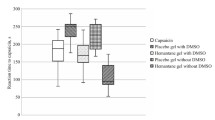Abstract
Oedema was induced in one ear of male mice of the CFLP strain with capsaicin solution (10 μl/40 μg/ear). The development in time and the extent of the oedema were determined by the oedema-disk gravimetric technique. The maximum oedema was attained in less than 1 h, and there was, subsequently, a gradual decrease. The extent of the mouse ear oedema induced in this way and measured after 60 min was inhibited to a statistically significant degree and in a dose-dependent manner by the antihistamine chloropyramine, the antihistamine-antiserotonin cyproheptadine, the non-steroidal anti-inflammatory agent piroxicam, the prostaglandin antagonist di-4-phloretin phosphate, and the lipoxygenase inhibitor nordihydroguairetic acid. The method proved suitable for the detection of oedema and for the biologically quantitative determination of the state of desensitization induced with capsaicin.
Similar content being viewed by others
References
A. Hőgyes,Beiträge zur physiologischen Wirkung der Bestandteile des Capsicum annuum. Arch. exp. Path. Pharmakol.9, 117–130 (1878).
M. Jancsó,Speicherung. Stoffanreicherung in Retikuloendothel und in der Niere. Akadémiai Kiadó, Budapest 1955.
M. Jancsó,Role of the nerve terminals in the mechanism of inflammatory reactions. Bull. Mill. Fillm. Hospital, Buffalo, N.Y.7, 53–77 (1960).
M. Jancsó,Inflammation and the inflammatory mechanisms. (Review Article). J. Pharm. Pharmacol.13, 577–594 (1961).
M. Gábor and Zs. Rázga,Influence of nonsteroidal antiphlogistics on mouse ear inflammation induced with croton oil. Arch. Int. Pharmacodyn. Ther.299, 241–246 (1989).
M. Gábor and Zs. Rázga,Effect of non-steroidal antiphlogistics on mouse ear oedema induced with dithranol. Acta Physiol. Acad. Sci. Hung.75, 187–191 (1990).
R. M. Virus and G. F. Gebhart,Pharmacologic actions of capsaicin: Apparent involvement of substance P and serotonin. Life Sci.25, 1273–1284 (1979).
J. Wallengren and R. Hakanson,Effects of substance P, neurokinin A and calcitonin gene-related peptide in human skin and their involvement in sensory nerve-mediated responses. Eur. J. Pharmacol.143, 267–273 (1987).
O. Hagermark, T. Hokfelt and B. Pernow,Flare and itch induced by substance P in human skin. J. Invest. Dermatol.71, 233–235 (1978).
Author information
Authors and Affiliations
Rights and permissions
About this article
Cite this article
Gábor, M., Rázga, Z. Development and inhibition of mouse ear oedema induced with capsaicin. Agents and Actions 36, 83–86 (1992). https://doi.org/10.1007/BF01991233
Received:
Accepted:
Issue Date:
DOI: https://doi.org/10.1007/BF01991233




